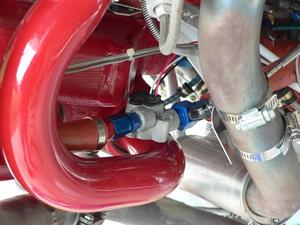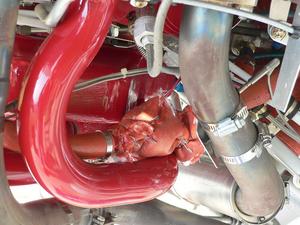The heat shield I needed to finish the fuel flow transducer work arrived this week, so I zipped out to the hangar early Saturday morning to finish the job. I also put in a new flexible fuel line from the fuel filter to the fuel pump inlet. The fuel flow transducer had been plumbed in between those two items, and I had temporarily connected those two lines with a union. But I knew that I would have a more reliable system if I could get rid of any extra connections, and I happened to have a flexible line in the basement that just happened to be the right length, so I put it in. I had feared that replacing the line would be a horrible job, as the input to the fuel pump is buried on the back of the engine, absolutely surrounded by inverted oil system lines, heat muff SCAT hose, throttle cable, etc. But, once I disconnected the heat muff SCAT hose, I just had enough access to get at the end of the hose.
I did a leak check using the boost pump, then put the cowling back on. I had planned a long cruise performance flight to check out the fuel flow indication, but I was running out of time to get back home so Terry could have the car. I almost decided to not go flying, but the wind was blowing 10 to 12 kt from the left, almost straight across the runway, and I didn’t want to miss any opportunity to expand the crosswind envelope. I did a quick circuit to a stop and go, then left the circuit for a quick check of the fuel flow as I leaned the mixture, then back into the circuit for a full stop landing. The fuel flow seemed to be much more stable than before, and the landings were quite acceptable.
 Here is the fuel flow transducer, in its new location, between the engine-driven fuel pump and the fuel injection servo.
Here is the fuel flow transducer, in its new location, between the engine-driven fuel pump and the fuel injection servo.
 Here it is after wrapping it in firesleeve. I’ll make up a new piece of firesleeve and put some RTV on the edges and let it cure before tying it in place. This was the first attempt - airworthy, but very ugly.
Here it is after wrapping it in firesleeve. I’ll make up a new piece of firesleeve and put some RTV on the edges and let it cure before tying it in place. This was the first attempt - airworthy, but very ugly.